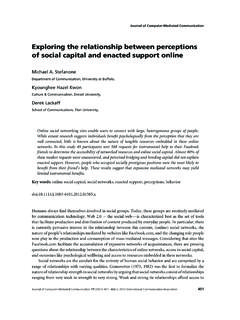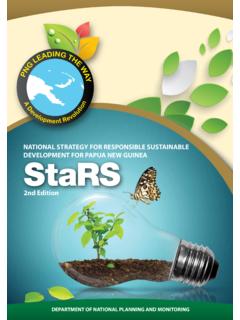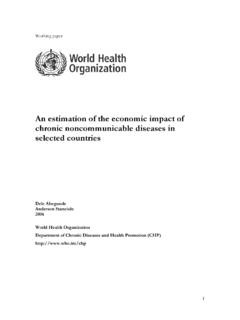Transcription of Social Protection Strategic Framework - UNICEF
1 1 Social Protection Strategic Framework Integrated Social Protection Systems: Enhancing equity for children Contents I. Concept Note for Consultation II. Annex A: Annotated Framework Outline III. Annex B: Consultation Strategy 2 Integrated Social Protection Systems: Enhancing equity for children UNICEF Social Protection Strategic Framework Concept Note for Consultation Summary and key messages The Social Protection Strategic Framework outlines UNICEF s approach to Social Protection , including priorities for current work and a proposed agenda for future action. UNICEF s work in Social Protection is a response to the organisation s mandate to fulfill children s rights, including the right to access services and an adequate standard of living. Social Protection contributes to UNICEF s equity-focused approach to development, as it helps to ensure equal access to services and is conducive to equitable human development outcomes for children.
2 The Framework presents UNICEF s conceptual understanding of Social Protection : proposed definition, core components, as well as rationale for UNICEF s work on child-sensitive Social Protection . UNICEF understands Social Protection as the set of public and private policies and programmes aimed at preventing, reducing and eliminating economic and Social vulnerabilities to poverty and deprivation. In this sense, it identifies four core components: Social transfers, programmes to ensure access to services, Social support and care services, and legislation and policy reform to remove inequalities in access to services or livelihoods/economic opportunities. UNICEF recognizes Social Protection as essential in furthering the rights of children and their families to an adequate standard of living and in achieving equitable outcomes, as well as a way to address the multidimensional nature of children s vulnerabilities.
3 The Framework promotes the development and strengthening of integrated Social Protection systems as a highly effective approach for addressing the multiple and compounding vulnerabilities faced by children and their families. It provides an overview of key design and implementation considerations, including instruments, structures, and challenges. The Framework also outlines three core principles for action: (i) Inclusive Social Protection ; (ii) Progressive Realization of Universal Coverage, and (iii) National Ownership and Context Specificity. Additionally, as a way forward, the Framework discusses emerging issues for Social Protection programming, including humanitarian action, youth development, urbanization and migration, and identifies potential roles for Social Protection , as well as research and practice gaps. Based on UNICEF s mandate as well as its local and global capacity and experience, the document discusses the organization s potential contribution and value-added vis- -vis other actors and partners in the field, and within the global Social Protection agenda.
4 3 I. Introduction UNICEF is committed to Social Protection as an essential intervention for the realization of children s rights to Social security, Social insurance and an adequate standard of Social Protection is also a crucial policy tool for supporting equity and Social justice. Social Protection measures strengthen the capacity of families to care for their children and remove barriers to services that stand in the way of achieving goals and progress for children. Evidence as well as UNICEF s own experience demonstrate the role of Social Protection in improving the lives of children, families and communities across the MDGs and beyond, often with stronger impacts for the poorest and most disadvantaged. Social Protection is thus an essential channel for filling the gap between populations that are adequately reached and those that are excluded, and for promoting equity in access to services and the realization of children s rights.
5 UNICEF has been working on Social Protection for many years as part of its global mandate to advocate for the Protection of children's rights, to help meet their basic needs and to expand their opportunities to reach their full potential. UNICEF is an increasingly influential partner in Social Protection at national and international levels. UNICEF s engagement in Social Protection spans over 124 programmes in 88 countries. This reflects a growing number of country programmes engaging in Social Protection policy, cash transfers, and family and Social support services, including those for orphans and vulnerable children (OVCs), as well as a number of other areas. Yet, in many ways, this widespread engagement is also a product of framing long-standing work in new and explicit ways: aspects of UNICEF s 1 Articles 26 and 27 Convention on the Rights of the Child (CRC).
6 Supported by other articles, including 18, 19, 28 and 32. existing work can be considered part of a Social Protection system UNICEF s work on education user-fee abolition, health insurance, and nutrition supplementation, for example. UNICEF work in Social Protection also includes a strong commitment and leadership in promoting the Social Protection Floor Initiative - joint effort to promote access to essential services and Social transfer for the poor and vulnerable - including supporting countries in the development of Social Protection priorities within this Framework . The Social Protection Strategic Framework aims to provide a clear Framework for UNICEF s work on Social Protection ; argue the case for Social Protection and children; articulate UNICEF s position on key issues, providing clear arguments and evidence; and outline a policy agenda for Social Protection and children, including UNICEF s contribution within a broader Social Protection agenda.
7 The Framework is currently undergoing consultation with external partners and stakeholders, and is expected to be completed by the end of 2011. 4 II. Making the case for Social Protection and children: The role of Social Protection in ensuring children s well-being and contributing to national development Increased relevance of Social Protection in current context Although Social Protection policies and programmes have been included as key components in the poverty reduction agendas of many countries, current developments and recent trends have increased their relevance and heightened the political momentum around them. Some of the key drivers for the renewed emphasis on Social Protection programmes and their proliferation worldwide are: concerns about the impact of increasing volatility at the macro and household levels, the persistence or increasing inequalities in economic and human development, the re-examination of sustainable development goals in light of the impacts of climate change, and changing population trends due to demographic changes and population 2 The Framework discusses these drivers and how Social Protection interventions have become a key policy tool to prevent and address global transformations and their impacts at the national and household levels.
8 The importance of children in Social Protection The Framework discusses UNICEF s rationale for Social Protection and children, including (i) internationally recognized children s rights to Social Protection ; (ii) child-sensitive Social Protection in response to the multidimensional and dynamic nature of children s vulnerabilities; (iii) the high returns to investment on children and 2 Ortiz et al (2010) Social Protection : Accelerating the MDGs with Equity . Social and Economic Policy Working Briefs. UNICEF Policy and Practice. impacts on intergenerational transmission of poverty; and (iv) Social Protection as a tool for achieving equitable outcomes. Children s right to Social Protection Social Protection is central to the UNICEF mission of realizing children s rights, including a focus on the most disadvantaged children.
9 As recognized by the Convention on the Rights of the Child (CRC), children have the right to Social security and insurance and to an adequate standard of living. Social Protection supports the realization of other rights laid out in the CRC and human rights documents. Social Protection interventions contribute to preventing, removing and eliminating the Social and economic vulnerabilities of children, women and their families. As such, it is considered to be a Strategic and essential tool in helping children and their families meet basic needs and in expanding their opportunities to reach their full Multidimensional nature of children s vulnerabilities: child-Sensitive Social Protection In addition to sharing many of the same sources of vulnerability faced by their families and communities, children face age-specific vulnerabilities which differ from those of adults or have more serious consequences, such as increased vulnerability to malnutrition, disease and abuse.
10 As we know, children also tend to be over-represented among the poor as stated by the 2005 Progress on Children Report, more than half of children in 3 CRC. See articles 26 and 27. 5 developing countries suffer from at least one form of severe Based on UNICEF s work on multidimensional child poverty and disparities, UNICEF has a unique role to play in ensuring that Social Protection programmes are responsive to children s rights and needs. Social Protection helps to protect people during vulnerable periods in the lifecycle. Child-sensitive Social Protection , therefore, considers different dimensions of children s well-being, and addresses the inherent Social disadvantages, risks and vulnerabilities children may be born into, as well as those acquired later in childhood.














